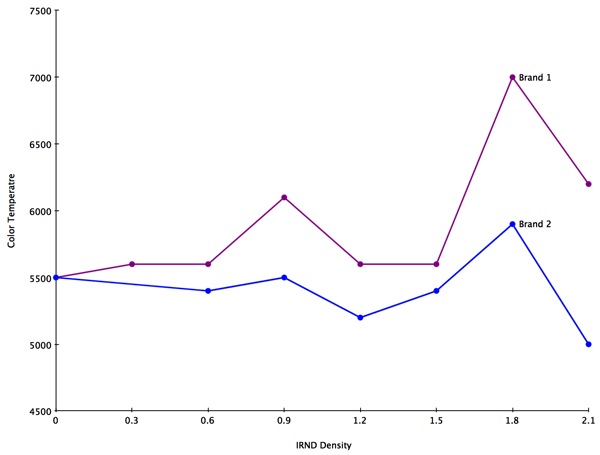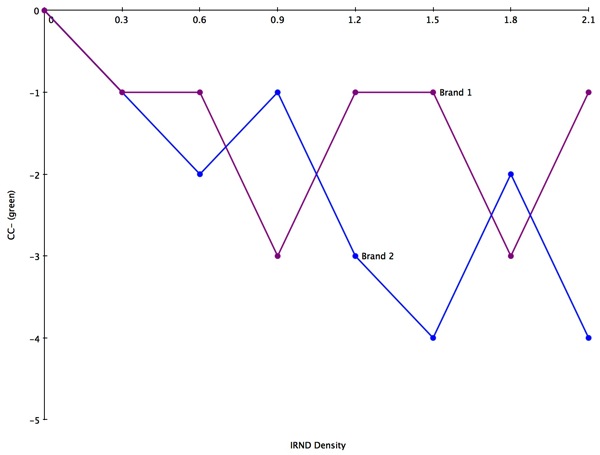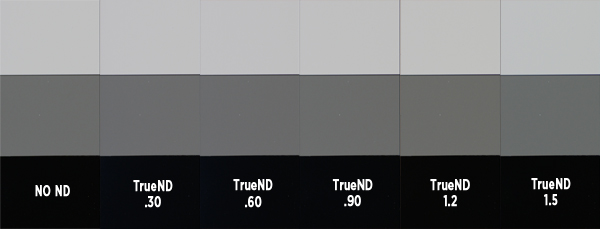A company by the name of Mitomo claims to have made a perfectly neutral ND filter that also cuts IR on every camera made. This is a spectacular claim and I was naturally skeptical when I first heard of this product. There’s only way to find out if this is true, so read on…
 One of the dirty little secrets of the film industry is that, historically, no one has made a truly neutral ND filter. In theory ND filters cut all visible light equally, but the sad reality is that they all shift color a bit. Some go a bit cool, some turn magenta… they all tend to shift in one direction or another depending on the brand.
One of the dirty little secrets of the film industry is that, historically, no one has made a truly neutral ND filter. In theory ND filters cut all visible light equally, but the sad reality is that they all shift color a bit. Some go a bit cool, some turn magenta… they all tend to shift in one direction or another depending on the brand.
It’s really difficult to manufacture perfectly neutral ND filters because the tolerances required for the heavier filters are really, really tight. An ND 1.8 passes about 1.5% of the visible light hitting it, so if the filter dyes aren’t absolutely perfect you’re going to see some sort of color shift at this density, guaranteed. My experience is that if a brand or set of ND filters is going to fail, ND 1.8 is where it’s going to happen. ND 1.5, which passes about 3% of the light that hits it, seems to be the the limit of what ND manufacturers can easily make.
Earlier this year I shot a test comparing two types of IRND filters and plotted the results on a graph. I shot a Chroma Du Monde chart with an Arri Alexa in Rec 709 mode and, while watching a waveform monitor and vectorscope, I manually white balanced the camera and noted the settings required to make each density of an IRND set neutral.
Here’s a graph showing how color temperature (warm/cool axis) varied between sets of IRND filters from two different manufacturers:

I recorded the color temperature adjustment (in degrees Kelvin) required to bring the white balance back to neutral. It’s interesting to see how variable the individual filters are, and how they generally trend toward cooler temperatures. It’s also interesting to see that the individual brand graphs roughly mirror each other: both seem to have issues with ND .9 and ND 1.8 filters drifting toward blue, while ND 1.5 and 2.1 are the closest to neutral in both sets.
Here’s a CC (green/magenta axis) comparison:

As the dye used to cut far red appears to be a yellowish green it’s normal to expect that all of the filters will trend green, but it’s interesting to see how much green is in each density of ND. The results of this test are a bit… confusing. I’d expect the density of the green dye to gradually increase as the filters get darker, but that’s not always the case. They’re all over the place (these graphs will appear in a future book on cinematography written by David Stump, ASC).
As I only tested one set of each brand I’m not going to name them. There are only three or four brands of this kind of filter on the market, so if you’re curious about your specific set you can do this test yourself and see what happens. I have no interest in making anyone look bad; rather, I just think it’s fascinating to see what is really happening in filters that we normally take for granted.
Now you know why I’m a bit skeptical when someone claims to be making a perfectly neutral ND, let alone an IRND.
It took me a while to get around to testing the Mitomo TrueND filters. BandPro sent a set to San Francisco-based Videofax but I was too busy shooting so they sat untouched for a month. When I finally did have time to test them I jumped in my car and drove about 200′ where one of the nicest people I’ve ever met drove their car into mine. It was two weeks before I was able to drive long distances again. (Thanks to BandPro for their patience!)
While I’d been told by BandPro that the TrueND filters cut IR, Videofax thought they were only meant to be perfectly neutral NDs. I brought both my DSC Labs OneShot chart and my tired and worn IR fabric chart along so I could test both aspects of the filters.
The trick with IR, or to be technically correct “far red” (red on the edge of human vision), is that normal ND filters don’t cut it but silicon sensors are very sensitive to it. Every camera lets a little bit of far red pass through to the sensor because flesh tones look a little dead otherwise. They lose a little bit of warmth and vibrance without a hint of that barely visible bit of spectrum.
Stacking regular NDs cuts most visible light but passes far red and IR, so the more ND you use the more far red you’ll see as the ratio of far red to visible light increases dramatically. This contamination manifests itself by turning certain dark fabrics and synthetic materials red or maroon, not because it’s technically “red light” (because it’s barely part of the visible spectrum) but because the red dyes on the sensor are the ones that typically let it pass. Any light that passes through the red dye filter on the sensor is interpreted as red light, regardless of whether it is pure red, orange red or barely visible red (RED cameras are sensitive to far red in both the blue and the red channels, as the blue dyes appear to have a leak in the far red part of the spectrum).
Most cameras cut a certain amount of IR and far red with a filter that’s stacked right on the sensor. Silicon is most sensitive to heat, so in a way we’re shaving off the part of the spectrum that the sensor likes the most in favor of using the rest, which is all we can see. Our eyes are sensitive to wavelengths between 400 and 700nm, so wavelengths above 700nm need to be trimmed away so that the camera doesn’t react to colors we can’t see. The on-sensor filter in most cameras trims the spectrum pretty close to 700nm, but RED cameras have an IR leak farther up the spectrum, around 750nm.
 Left: this image is from an excellent IOS app called Gel Swatch Library. It not only shows the rough color of every filter made by all the major manufacturers but it shows what parts of the spectrum the gel passes. In the case of Lee 211 ND .9 gel you can see how the gel starts to pass light toward the red end of the spectrum. This is typical of all dye ND filters.
Left: this image is from an excellent IOS app called Gel Swatch Library. It not only shows the rough color of every filter made by all the major manufacturers but it shows what parts of the spectrum the gel passes. In the case of Lee 211 ND .9 gel you can see how the gel starts to pass light toward the red end of the spectrum. This is typical of all dye ND filters.
The extra far red/near IR that we see when using NDs isn’t a mistake on the part of camera manufacturers; they need to pass some of that spectrum to the sensor in order to make flesh tone appear alive and healthy. It’s the filter manufacturers that haven’t made ND filters that cut excess far red/near IR in the same proportion as the rest of the spectrum.
Trimming wavelengths just above and below 700nm (which is technically part of the red spectrum but is on the edge of what we can actually see) can be done using dye absorption, where the filter is dyed one color that absorbs another. As all IRND filters seem to be yellow-green it appears that this color is the one that will absorb that extra bit of barely visible red. The amount of this color used in an ND varies, as heavier densities require more green to cut more far red.
RED’s far red leak is a bit higher in the spectrum, and as that part of the spectrum doesn’t really count as visible light it’s a bit more difficult to find a dye that will absorb it. Instead manufacturers make filters called hot mirrors, which use a dichroic process to place very fine layers of metal on the surface of the glass filter base that can cut through the spectrum like a knife. Wavelengths above the cutoff point bounce off the filter as if off a mirror, and as those wavelengths are closer to infrared (heat) than the visible spectrum it makes sense to call these filters hot mirrors.
Because of this difference between sensor sensitivities, every camera with a far red problem can solve it with a set of dye-based IRND filters… except for RED cameras, which require a hot mirror filter. The good news is that one hot mirror filter will work with any number of regular NDs, whereas IRNDs must be used as part of an IRND set.
You can mix hot mirrors with regular NDs, but you can’t mix IRNDs with regular NDs. It’s all a bit confusing. I regularly hear stories from rental houses of DPs who will rent a set of IRNDs with a RED package, and I just shake my head.
We’re going to look at two things in these tests, color neutrality and far red absorption. Let’s look at color neutrality first:

I had to use the ND filters that Videofax had on hand, and as they were quite busy I had to use a mixed set of Schneider and Tiffen NDs to make a set comparable to the TrueND filters. (BandPro sent me strengths from .30 to 1.5.) The biggest problem with ND filters is that it’s tremendously difficult to make them color neutral. An ND 1.5 filter passes about 1.5% of the visible light striking it, so the dye tolerances have to be very, very precise to avoid color shifts. This is almost impossible to do with higher strength NDs, so different manufacturers trend toward different hues. This particular set of ND filters shows Schneider NDs turning more and more magenta as density increases, while the Tiffen 1.5 has a little bit of a tobacco hue to it.
Now let’s look at the TrueND filters:

There are some very subtle hue shifts, but nothing terribly strong. The 1.5 looks very neutral, and that should be the hardest one to get right. I watched a vectorscope while shooting these tests and the slight hue differences didn’t register at all, and when I sampled these images in Photoshop the RGB values never strayed more than 3 code values from the neutral reference. In order:
No ND: 192, 192, 192
ND .30: 192, 192, 193
ND .60: 191, 191, 192
ND .90: 192, 191, 190
ND 1.2: 192, 191, 191
ND 1.5: 188, 192, 190
I’m tempted to say that those subtle differences in hue are no more than I’ve seen when switching lenses. These ND filters are certainly more consistent than any I’ve seen before.
Continue on to Page Two: TrueND Filters with the Arri Alexa
Continue on to Page Three: TrueND Filters with the RED Epic
